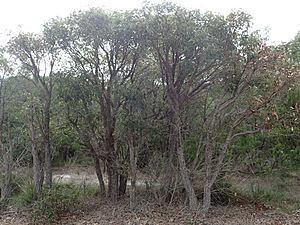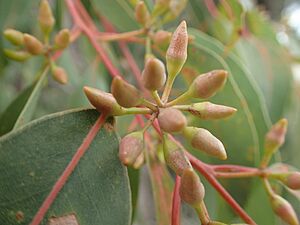Albany blackbutt facts for kids
Quick facts for kids Albany blackbutt |
|
|---|---|
 |
|
| Eucalyptus staeri in the Torndirrup National Park | |
| Scientific classification | |
| Genus: |
Eucalyptus
|
| Species: |
staeri
|
Eucalyptus staeri, commonly known as Albany blackbutt, is a special type of Eucalyptus tree. It's usually a small tree or a mallee, which means it's a shrubby tree with many stems growing from the ground. This plant only grows in the south-west part of Western Australia. It's easy to spot with its rough bark, thick, long leaves, and creamy white flowers.
Contents
What Does Albany Blackbutt Look Like?
The Albany blackbutt is a tree or a mallee. It usually grows to be about 2 to 15 meters (6 to 49 feet) tall. It has a special woody swelling at its base called a lignotuber. This helps the plant regrow after fires.
Bark and Stems
The bark on the trunk and branches is rough and fibrous. It's greyish-brown and has cracks in it. Young plants have stems that are square-shaped.
Leaves of the Albany Blackbutt
Young plants have leaves that are lighter green underneath. These leaves are egg-shaped to broadly lance-shaped. They are about 8 to 14 cm (3 to 5.5 inches) long and 3 to 6 cm (1 to 2.5 inches) wide.
Adult leaves are the same shade of green on both sides. They are lance-shaped, about 8 to 12.5 cm (3 to 5 inches) long. They are about 1.8 to 3.5 cm (0.7 to 1.4 inches) wide. These leaves have a stalk called a petiole, which is about 1 to 2.3 cm (0.4 to 0.9 inches) long.
Flowers and Fruit
The flower buds grow in groups of 7 to 15. They are found where the leaf meets the stem, called a leaf axil. Each group of buds sits on a flat stalk called a peduncle, which is about 1.4 to 2.3 cm (0.5 to 0.9 inches) long. Individual buds have smaller stalks called pedicels, about 0.5 to 1.9 cm (0.2 to 0.7 inches) long.
Mature buds are shaped like a cylinder or a spindle. They are about 1.3 to 2 cm (0.5 to 0.8 inches) long and 0.5 to 0.7 cm (0.2 to 0.3 inches) wide. They have a cone-shaped cap called an operculum. The flowers are creamy white and bloom from August or October to December or January or April.
After flowering, the plant produces woody, round fruit. These fruits are called capsules. They are about 1.4 to 2.3 cm (0.5 to 0.9 inches) long and 1.6 to 2.2 cm (0.6 to 0.9 inches) wide. The seed-releasing parts are below the rim of the fruit.
How Albany Blackbutt Got Its Name
The Albany blackbutt was first described in 1914 by a botanist named Joseph Maiden. He first called it Eucalyptus marginata var. staeri.
Later, in 1924, two other botanists, Stephen Lackey Kessell and Charles Gardner, changed its status. They decided it was a unique species and named it Eucalyptus staeri. The name staeri honors John Staer (1850-1933). He was the person who collected the first samples of this plant. These samples are called type specimens.
Where Does Albany Blackbutt Grow?
The Albany blackbutt is mostly found in the south-west part of Western Australia. It grows around the town of Albany. Smaller groups of these trees can also be found further north in the Wheatbelt region.
This eucalypt prefers to grow in sandy soil. You can often find it in scrubland areas close to the coast.
Is Albany Blackbutt Endangered?
The Western Australian Government's Department of Parks and Wildlife has classified this eucalypt as "not threatened." This means it is not currently at risk of disappearing.



